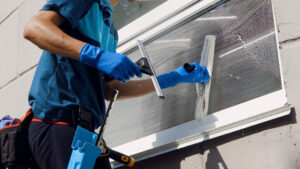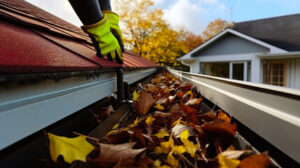Keeping windows clean is an important part of home maintenance. It allows natural light to filter into the house and makes rooms appear larger and brighter.

To avoid streaks when washing windows, wipe with a lint-free cloth, such as a chamois or microfiber towel, or even a newspaper. When you finish cleaning the glass, buff away any streaks with a dry, lint-free cloth.
The frames around windows collect dirt, dust, and grime just as the glass does. To keep your home looking its best, it’s important to clean the frames regularly. To do this, you need a gentle yet potent cleaning solution that will safely remove dirt and residue from the frames without damaging them. Mix equal parts warm water and mild detergent to create the cleaning solution, then use it to wipe down the frames. Be sure to take your time and go over every surface of the frame, paying special attention to nooks and crannies where dirt often accumulates.
If your window frames are particularly dirty, try using a mineral deposit removing cleaner, such as CLR or Bar Keepers Friend. These products break down the oxidation caused by minerals in the water and allow you to scrub away stubborn dirt. If your frames are still dingy after using these products, you may need to use a stainless steel wire brush to scrub off the residue and stains.
Before you begin the actual cleaning process, use a vacuum cleaner with a crevice tool attachment or a cloth to clear out any loose dirt in the window tracks and frames. This will make the job much easier and ensure that the rest of your cleaning will be free from caked on gunk.
Afterwards, spray the track with a mixture of vinegar and water until it is thoroughly saturated. Wait a few minutes to let the vinegar and water react with each other, then use a paper towel to wipe down the entire vertical track from one end to the other. Repeat the process on the bottom track to ensure that you get all the gunk from the corners and grooves of each track.
After you’re done, use a lint-free cloth to dry the track and frame. This will prevent the growth of mold or mildew and also help to avoid unsightly streaks on your windows. To speed up the drying process, it’s a good idea to spray the track with water both before and after you wipe it down.
Clean the Glass
Using a dry lint-free cloth, either a microfiber or a terrycloth rag, wipe the glass from top to bottom. Immediately afterward, use another clean lint-free microfiber cloth to buff away any solution residue and remove streaks. Doing this quickly prevents the cleaning agent from drying and becoming difficult to remove. If you have more than one window to wash, it’s best to work on them in sections rather than all at once.
Avoid using paper towels, old rags or newspapers to clean windows. These materials can scratch or leave black ink smudges on glass surfaces. Instead, invest in reusable microfiber cloths that are super absorbent and washable. Alternatively, you can purchase a squeegee to help get the job done.
If you don’t have a microfiber cloth, a squeegee or a rag that is lint-free, use a soft abrasive sponge to rub the dirt and water off the glass. Then, use a squeegee to wipe the window dry. Be sure to rinse the squeegee between uses to prevent it from leaving behind dirty water marks on your windows.
For stubborn stains, try a mineral deposit remover such as CLR. If this fails, make a paste from water and cleaner that contains oxalic acid such as Zud or Bar Keepers Friend. Apply this to the affected area, let it sit for 15 minutes or so and then rinse it off. This may be necessary on exterior or insulated windows with heavy deposits of calcium or lime.
You can also use a de-ionized water spray or commercial cleanser to wash your windows and doors. This type of water is different from regular tap water and does not contain any ions that attract dirt, so your windows will stay clean longer. If you are cleaning a tall window, consider investing in a water-fed pole that allows you to spray or mop from the ground rather than standing on ladders. This method of washing your windows eliminates the need for chemical sprays that can contaminate the environment and cause toxic fumes. You can find these types of poles online or at some home improvement stores.
Clean the Sills
A window sill collects a lot of residue from the outside environment. A quick wiping down may refresh its appearance, but periodic deep cleaning is necessary for sanitation and to keep it looking like new. Unlike window tracks, a dirty sill will show dirt and dust on its surface and can harbor germs and other pollutants that can affect indoor air quality. For this reason, it is particularly important to keep window sills clean as part of your regular maintenance cleaning.
If you have wood window sills, start by brushing them to remove any loose debris and dirt. Then use a microfiber cloth or duster to wipe them down and make sure you get into all of the nooks and crannies. For stubborn stains, you can use a mild abrasive cleaner. Aluminum window sills are tough enough that water alone should be sufficient, but if you’re having trouble with a hard-water spot or mildew, you can use a gentle commercial cleaner formulated for this type of material.
For moldy window sills, you can try using a mixture of equal parts baking soda and water. Apply the paste to the affected area and let it sit for ten minutes. This will help to dissolve the mold and then you can wipe it away with a damp cloth. For hard-water stains, you can also try a mild solution of bleach and water in a spray bottle. This will kill any germs and prevent mold spores from growing.
Brick window sills should be cleaned the same way as a standard brick surface, although you may need to use a slightly more abrasive method to scrub stubborn stains and build-up. Brick is porous, so it can easily absorb substances from the surrounding environment that can stain and discolor it. For this reason, it is a good idea to thoroughly rinse the sill after cleaning and then wipe it dry with a clean cloth to prevent excess moisture from leading to mold growth.
In addition to being a magnet for dust, dirt, and debris, wood window sills can also become a breeding ground for harmful organisms such as mold and mildew. This is why it’s particularly important to clean them regularly and completely to protect the health of your family and guests.
Clean the Windowsill
The window sill is the structure that holds the glass panes of your windows in place. It is the most visible part of your windows, so it should be cleaned regularly to keep it looking its best. This is an easy task that can be done with a microfiber cloth and cleaning solution or even just vinegar.
Adding this to your regular cleaning routine will help prevent future mold and dirt buildup. To clean the sill, start by removing any larger, loose debris. This includes dust bunnies, dead bugs and twigs. A vacuum cleaner with a crevice tool attachment will work well to get the job done quickly and efficiently.
Next, you will want to remove any mold that has formed on the window sill. For this, you will want to use a solution of equal parts water and hydrogen peroxide (3%) in a spray bottle. This will effectively kill any mold on the surface of your window sill, as it is safe for wood and penetrates porous surfaces to kill any mycelium or spores. After sprinkling the solution on the affected area, let it sit for about 10-15 minutes. Then, using a scrub brush and warm soapy water, gently scrub the area, being sure to pay special attention to any nooks and crannies. Once you are finished, wipe away any leftover soapy residue with a damp microfiber cloth.
If you notice that there is still a lot of gunk stuck to the window track, you may need to put in some more elbow grease. This is where a scrub brush or sponge with a scrubby side comes in handy. This will help remove caked on dirt, which may include bird poop, tree debris or construction dust.
When the track is completely clean, use a lubricant to make it slide easily open and closed. Vinyl tracks can be coated with silicone lubricant, while wooden window tracks should be coated with a high-quality furniture wax.
It’s always a good idea to use non-toxic cleaners, as harsh chemicals may damage your window frames and sills. If you do want to use a commercial product, opt for a wood-safe cleaner like Pinesol. Be careful not to oversaturate the wood, as this can cause it to warp or crack.
